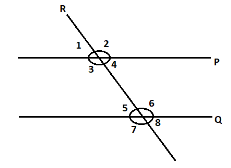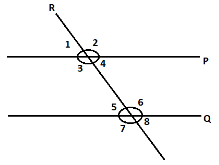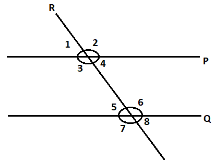Answer
417.9k+ views
Hint: According to the question given in the question we have to determine that the statement If two parallel lines are cut by transversal, then a pair of alternate interior angles not equal is true or false. So, first of all we have to draw two parallel lines and a transversal line which intersects the two parallel lines which is as below:

Hence, from in the diagram above lines P and Q are parallel to each other and a transversal line R intersects the both of the parallel lines P and Q and all the interior angles are $\angle 1,\angle 2,\angle 3,\angle 4,\angle 5,\angle 6,\angle 7,$ and $\angle 8$.
Now, we have to use the transversal theorem to determine when two parallel lines are cut by transversal, then pair of alternate interior angles not equal is true or not which is explained below:
According to transversal theorem if two parallel lines are intersected by another transversal line then the alternate interior angles formed are congruent or we can say equal to each other.
Complete step-by-step solution:
Step 1: First of all we have to draw the diagram for If two parallel lines are cut by transversal, then a pair of alternate interior angles not equal is true or false. So, first of all we have to draw two parallel lines and a transversal line which intersects the two parallel lines as mentioned in the solution hint. Hence,

Step 2: Now, as we know that when two lines are intersected by a transversal line, then pairs of angles on one side of the transversal line which is R and inside the two lines P and Q are known as the consecutive interior angles. Hence, from the diagram as mentioned in the solution step 1,

$
\Rightarrow \angle 1 = \angle 5, \\
\Rightarrow \angle 3 = \angle 7, \\
\Rightarrow \angle 2 = \angle 6,and \\
\Rightarrow \angle 4 = \angle 8
$
Hence, If two parallel lines are cut by transversal, then a pair of alternate interior angles not equal is false.
Therefore option (B) is correct.
Note: If two parallel lines are intersected by another transversal line then the alternate interior angles formed are congruent or we can say equal to each other.

Hence, from in the diagram above lines P and Q are parallel to each other and a transversal line R intersects the both of the parallel lines P and Q and all the interior angles are $\angle 1,\angle 2,\angle 3,\angle 4,\angle 5,\angle 6,\angle 7,$ and $\angle 8$.
Now, we have to use the transversal theorem to determine when two parallel lines are cut by transversal, then pair of alternate interior angles not equal is true or not which is explained below:
According to transversal theorem if two parallel lines are intersected by another transversal line then the alternate interior angles formed are congruent or we can say equal to each other.
Complete step-by-step solution:
Step 1: First of all we have to draw the diagram for If two parallel lines are cut by transversal, then a pair of alternate interior angles not equal is true or false. So, first of all we have to draw two parallel lines and a transversal line which intersects the two parallel lines as mentioned in the solution hint. Hence,

Step 2: Now, as we know that when two lines are intersected by a transversal line, then pairs of angles on one side of the transversal line which is R and inside the two lines P and Q are known as the consecutive interior angles. Hence, from the diagram as mentioned in the solution step 1,

$
\Rightarrow \angle 1 = \angle 5, \\
\Rightarrow \angle 3 = \angle 7, \\
\Rightarrow \angle 2 = \angle 6,and \\
\Rightarrow \angle 4 = \angle 8
$
Hence, If two parallel lines are cut by transversal, then a pair of alternate interior angles not equal is false.
Therefore option (B) is correct.
Note: If two parallel lines are intersected by another transversal line then the alternate interior angles formed are congruent or we can say equal to each other.
Recently Updated Pages
Mark and label the given geoinformation on the outline class 11 social science CBSE

When people say No pun intended what does that mea class 8 english CBSE

Name the states which share their boundary with Indias class 9 social science CBSE

Give an account of the Northern Plains of India class 9 social science CBSE

Change the following sentences into negative and interrogative class 10 english CBSE

Advantages and disadvantages of science

Trending doubts
Difference between Prokaryotic cell and Eukaryotic class 11 biology CBSE

Fill the blanks with the suitable prepositions 1 The class 9 english CBSE

Differentiate between homogeneous and heterogeneous class 12 chemistry CBSE

Difference Between Plant Cell and Animal Cell

Which are the Top 10 Largest Countries of the World?

10 examples of evaporation in daily life with explanations

Give 10 examples for herbs , shrubs , climbers , creepers

Write a letter to the principal requesting him to grant class 10 english CBSE

Change the following sentences into negative and interrogative class 10 english CBSE



